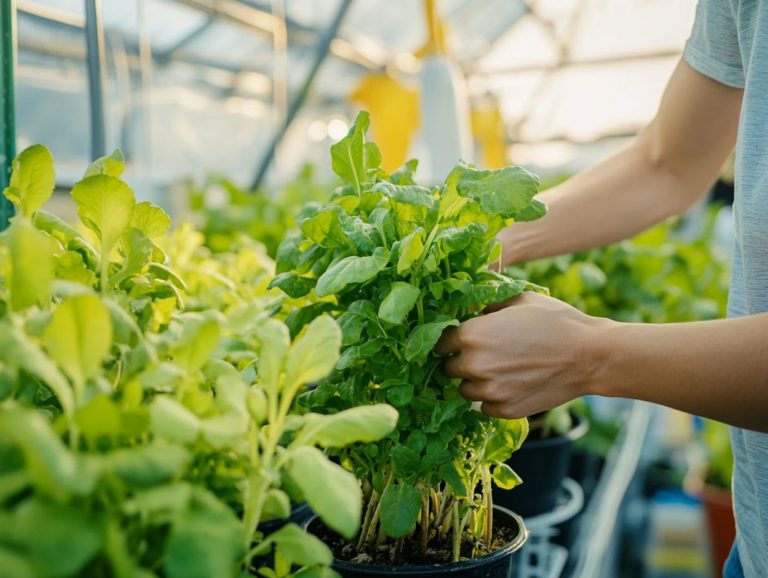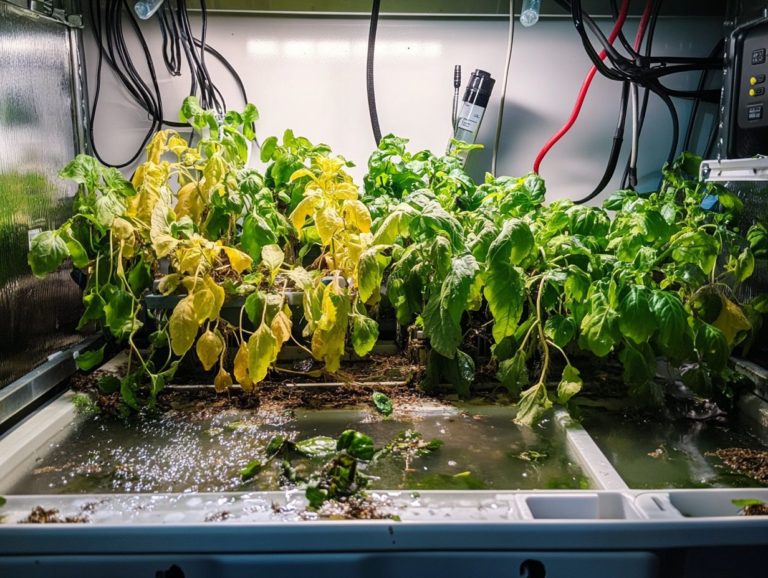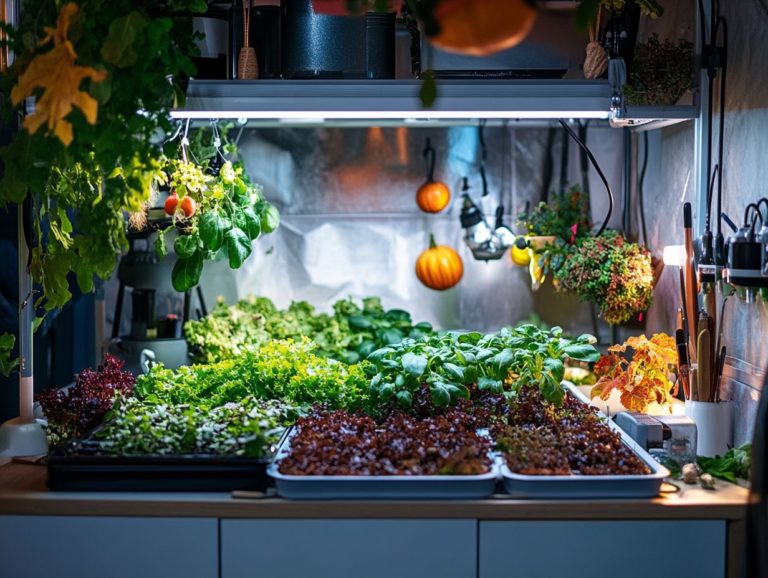How to Keep Your Hydroponic System Clean
Hydroponic gardening presents an innovative opportunity to cultivate plants without the need for soil. Maintaining a clean system is vital for ensuring your plants thrive and yield the best results.
This guide will show you why keeping your hydroponic system clean is crucial for thriving plants and how to do it easily! You’ll discover a step-by-step process to thoroughly clean your system, along with tips to prevent common issues such as algae growth.
By prioritizing cleanliness, you can guarantee that your hydroponic garden remains healthy and productive!
Contents
Key Takeaways:

- Regularly cleaning your hydroponic system is key for vibrant plants and high yields!
- Essential cleaning tools like scrub brushes and hydrogen peroxide effectively remove algae and other contaminants.
- A thorough cleaning routine should include flushing and refilling the system, along with regular maintenance to prevent build-up of bacteria or algae.
What is Hydroponic Gardening?
Hydroponic gardening is a modern way to grow plants without soil. It uses nutrient solutions and water in a controlled environment. This technique enables you to achieve the best growth for various plants, especially vegetables, by delivering nutrients directly to the roots.
Hydroponics offers a more efficient means of crop cultivation, making it a favored choice among both commercial growers and dedicated homesteaders.
With the capacity to monitor and adjust essential factors like light, temperature, and pH levels, hydroponic systems enable you to produce healthy plants year-round. This ensures the right Electrical Conductivity/Parts Per Million, which measures nutrient concentration, for growth.
This gardening practice boasts a rich history, tracing back thousands of years. Historical evidence suggests that the ancient Babylonians employed similar concepts to create their renowned hanging gardens. Over time, hydroponics has advanced into sophisticated systems, including deep water culture and nutrient film techniques, each providing unique advantages tailored to diverse growing conditions.
One standout benefit of hydroponics is its remarkable efficiency in using water and space. By nurturing plants in a nutrient-dense solution rather than soil, you can maximize your yields while minimizing resource waste. The use of inert growing mediums, such as rock wool and clay pellets, further enhances this method, providing stability and aeration for the roots.
Ultimately, hydroponic gardening reduces the risk of pests and diseases commonly linked to soil and accelerates plant growth, making it an increasingly appealing choice for sustainable agriculture and indoor farming.
The Importance of Keeping Your Hydroponic System Clean
Maintaining a pristine hydroponic system is essential for achieving optimal plant growth and health. A clean environment significantly reduces the risk of bacteria, algae, and other contaminants that can jeopardize the quality of your nutrient solution, ultimately impacting the yield of your vegetables.
By committing to regular cleaning and maintenance, you enhance nutrient uptake and foster robust root systems, allowing your plants to truly flourish in their hydroponic setup. To avoid issues, it’s important to learn how to prevent hydroponic system failures. In the world of hydroponics, where cleanliness reigns supreme, neglecting proper maintenance can lead to unexpected problems throughout the growing cycle.
Therefore, it s vital for both commercial growers and homesteaders alike to prioritize hygiene in their systems. Start your cleaning routine today to boost your garden s health and productivity!
Benefits of a Clean System
A clean hydroponic system brings a wealth of benefits vital for your plants’ success. By maintaining cleanliness, you can drastically minimize the risk of algae and bacteria taking over your nutrient solution, which translates to healthier plants and more impressive yields.
A pristine environment boosts nutrient absorption and wards off diseases that contaminants might introduce. Plus, keeping your hydroponic system clean extends the life of crucial components like reservoirs and filters, optimizing overall efficiency.
Whether you’re in commercial farming or pursuing home farming, recognizing the advantages of a clean system can lead to more fruitful harvests and greater efficiency in your growing medium.
With enhanced nutrient absorption, your plants will flourish, tapping into essential minerals for faster growth and increased vigor. By cutting down on disease prevalence, you create a stable growth environment, reducing reliance on expensive treatments that can strain your budget.
Over time, the savings from lower maintenance costs, fewer replacements, and optimized nutrient solutions can significantly boost your profitability. Make cleanliness your top priority! You cultivate not just robust plants but also a more sustainable and cost-effective hydroponic operation, enabling you to achieve your agricultural aspirations with greater ease.
Tools and Supplies for Cleaning Your Hydroponic System
To properly clean your hydroponic system, you need specific tools and supplies tailored for thorough maintenance. Using the right cleaning tools makes the process efficient while safeguarding the health of your plants and the integrity of your nutrient solution.
Essential supplies include scrubbers, brushes, and cleaning solutions specifically designed for hydroponic systems, all aimed at preventing algae and bacteria growth in your reservoirs and tubing. For effective maintenance, it’s also important to have the right tools for hydroponic maintenance. Keeping a log to track your cleaning activities helps streamline the process, helping both commercial growers and home farmers effortlessly adhere to best practices.
Essential Cleaning Tools

Essential cleaning tools should definitely include scrubbers, brushes, and specialized cleaning equipment tailored to effectively eliminate algae and bacteria. These tools are crucial for maintaining the cleanliness of your reservoirs, tubes, and containers, ensuring your nutrient solution stays uncontaminated.
By regularly employing these tools, you can significantly minimize the buildup of harmful substances that could negatively impact plant health especially in tightly controlled indoor environments where contaminants can spread quickly. Scrubbers excel at tackling stubborn algae growth on surfaces, while both soft and stiff brushes help you reach tricky spots, ensuring every corner is properly cleaned.
Incorporating specialized cleaning solutions can boost the efficacy of these tools, providing a more thorough approach to hygiene. Consistent attention to detail not only cultivates a healthier growing environment but also enhances the overall yield and productivity of your hydroponic system.
It’s essential for both hobbyists and commercial growers to prioritize these cleaning practices for optimal results.
Start cleaning your hydroponic system now with tips on how to maintain your hydroponic growing system to enjoy better results!
Recommended Cleaning Solutions
Recommended cleaning solutions for hydroponic systems include hydrogen peroxide and bleach. Both are effective at eliminating algae and bacteria from various components. These cleaning agents are crucial for ensuring that your nutrient solution a mixture of water and essential nutrients plants need to grow remains uncontaminated, promoting overall plant health and yield.
Selecting the right cleaning solution and using it in appropriate concentrations can significantly enhance the cleanliness of your system. This minimizes risks to the plants you re growing.
Hydrogen peroxide, for instance, is typically recommended at a concentration of around 3% for effective cleaning. This ensures it won t harm those delicate plant roots. Regarding bleach, a diluted solution of about 10% usually does the trick. It s essential to rinse thoroughly afterward to eliminate any residual chlorine that could be detrimental to your plants.
Both solutions sanitize surfaces and reduce the risk of pathogens that might interfere with nutrient absorption.
Remember to always wear gloves and work in well-ventilated areas to prioritize safety. This ensures your hydroponic setup remains clean and conducive to robust plant growth, particularly in indoor environments.
Step-by-Step Guide to Cleaning Your Hydroponic System
Cleaning your hydroponic system requires an organized method to ensure that every component is meticulously maintained for optimal plant health. By following this step-by-step guide, you can create an effective cleaning routine that addresses every part of your hydroponic setup, from reservoirs to tubing.
This guide will lead you through essential steps: preparing the system for cleaning, scrubbing the components, and flushing and refilling with fresh nutrient solution. By maintaining a clean system, you will significantly elevate the growth environment for your plants. Additionally, being aware of signs your hydroponic system needs maintenance can pave the way for healthier and more productive harvests.
Preparing the System for Cleaning
Preparing your hydroponic system for a thorough cleaning requires a mindful approach to ensure effectiveness. Start by disconnecting the nutrient solution and draining any remaining water from the reservoirs and containers. This crucial step prevents contamination and allows the cleaning solutions to reach every surface efficiently.
Be sure to dispose of your nutrient solution carefully to protect our planet! This not only maintains the integrity of your system but also safeguards the surrounding environment.
Once everything is drained, take a moment to inspect the tubing, pumps, and other components for any sediment buildup, leaks, or signs of wear. This proactive check can save you time and resources down the line.
If you uncover any discrepancies, addressing these before the cleaning process can significantly enhance your hydroponic system’s performance. With everything disconnected and inspected, you are now in an excellent position to implement a comprehensive cleaning protocol that targets all areas requiring attention, which is crucial for understanding hydroponic system maintenance.
Cleaning the Components
Cleaning the components of your hydroponic system is essential for maintaining both cleanliness and plant health. Utilize scrubbers and brushes to meticulously clean reservoirs, tubing, and containers. This effectively eliminates any algae or bacteria buildup.
Pay close attention to often-overlooked areas, as they can become breeding grounds for contaminants that compromise your nutrient solutions.
By systematically addressing each component, you create a healthy and balanced environment for your plants, optimizing their growth potential.
A diluted vinegar solution can serve as a highly effective natural disinfectant, helping to break down stubborn residues. For your tubing, employing a long-reaching pipe cleaner can dislodge any trapped particles, while regular rinsing with clean water ensures that no cleaning agents remain behind.
When cleaning growing media, consider using a mild hydrogen peroxide solution to eliminate pathogens without harming the beneficial microbes that support your plants.
Each method you implement enhances the performance of your hydroponic system and contributes to the longevity of its components. This ultimately fosters a thriving ecosystem for your plants.
Flushing and Refilling the System

Flushing and refilling your hydroponic system is crucial for revitalizing the nutrient solution and ensuring your plants thrive. Start the flushing process by running clean, filtered water through every component to eliminate any residual cleaning solutions and contaminants. Once everything is pristine, refill the system with a fresh nutrient solution tailored to the specific needs of your plants. This keeps things clean and supports healthy growth by providing the right balance of essential nutrients.
Make sure the flushing lasts several minutes to thoroughly cleanse all corners of the system. Use purified water, as tap water may contain chlorine or other impurities that could hinder nutrient absorption. After flushing, mix your nutrient solution according to the manufacturer’s guidelines to achieve the correct EC and pH levels. For comprehensive care, consider following seasonal maintenance tips for hydroponics. These are vital for optimal nutrient uptake.
Regularly monitoring these levels helps your plants absorb the macro and micronutrients they need for robust growth and impressive yields.
Maintenance Tips for a Clean Hydroponic System
Effective maintenance tips for a pristine hydroponic system can greatly enhance the longevity and productivity of your plants. Prioritize regular cleaning and scheduled maintenance to prevent the buildup of algae and bacteria, which could compromise the health of your nutrient solution.
Keeping a cleaning log is an invaluable tool. It helps you stay organized with your maintenance activities and pinpoint any recurring issues. By adhering to these maintenance guidelines, both commercial growers and homesteaders can cultivate an environment that nurtures optimal plant growth and ensures exceptional harvest quality. For more detailed strategies, check out this guide on how to maintain hydroponic system efficiency.
Regular Cleaning Schedule
Create a clear schedule that lists cleaning tasks and when to do them. Establishing a regular cleaning schedule for your hydroponic system is essential for maintaining cleanliness and preventing contamination.
Keep a log to track your cleaning activities. Note any observations regarding algae growth or other contaminants. This proactive strategy enables you to identify patterns and make necessary adjustments, which is vital whether you’re a commercial grower or a homesteader aiming to optimize plant health and maintain water quality in hydroponic systems for better harvests.
To effectively implement this schedule, designate specific days of the week or month for routine tasks, such as cleaning nutrient reservoirs, inspecting pumps, and wiping down surfaces. Set aside time for weekly checks to spot visible algae and plan monthly deep cleans where you disassemble all components for a thorough wash. Additionally, consider preventing algae growth in hydroponic systems to maintain optimal conditions.
Utilizing a maintenance log is invaluable. It helps you track cleaning frequency, highlights areas needing attention, and notes the health of your plants post-cleaning. By adopting this approach, you ensure not only the longevity of your system but also the overall success of your hydroponic endeavors. For more detailed insights, check out this guide on how to maintain hydroponic equipment.
Preventing Algae and Other Contaminants
Keep your hydroponic system thriving by preventing algae and other contaminants! Regular maintenance, which includes thorough cleaning and vigilant monitoring of nutrient solutions, is key to minimizing the risk of contamination.
Here are some effective measures to consider:
- Establish a consistent schedule for cleaning and sterilizing all components, such as reservoirs, tubing, and growth trays.
- Maintain optimal environmental conditions by carefully regulating light exposure and temperature.
- Incorporate UV sterilization and introduce beneficial microorganisms to enhance cleanliness.
- Keep a close watch on water pH and nutrient levels to manage plant health and prevent algae outbreaks.
By adopting these practices, you will elevate hygiene standards and cultivate a vibrant and productive hydroponic garden.
Frequently Asked Questions
What is Hydroponics?
Hydroponics is a method of growing plants in water with nutrients, without the use of soil.
Keeping your hydroponic system sparkling clean is essential for vibrant plants! Cleanliness prevents the buildup of bacteria, algae, and other contaminants that can harm your plants.
What are Some Common Methods for Cleaning a Hydroponic System?
Some effective ways to keep your hydroponic system clean include:
- Using natural cleaners
- Regularly changing the water and nutrients
- Maintaining proper pH and nutrient levels
Can I Use Regular Household Cleaners?
No! Regular household cleaners may contain harmful chemicals that can be absorbed by your plants. Instead, opt for natural cleaners or specially formulated hydroponic cleaners.
How Often Should I Clean My Hydroponic System?
Clean your hydroponic system at least once a month. However, the frequency may vary based on your system’s size, type, and how quickly it accumulates dirt.
What are Some Signs My Hydroponic System Needs Cleaning?
If you notice a slimy or foul odor from your system, or if your plants show signs of nutrient deficiencies, it’s crucial to clean immediately!
Specific Tips for Keeping Your Hydroponic System Clean
Here are some handy tips:
- Regularly check and adjust pH and nutrient levels
- Use a filter to remove debris
- Utilize a sterilizer or UV light to prevent bacterial and algal growth







